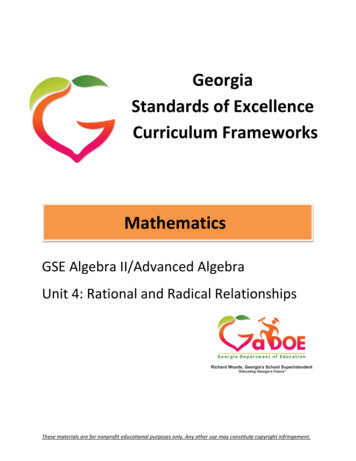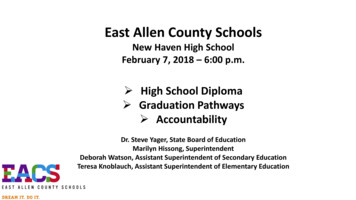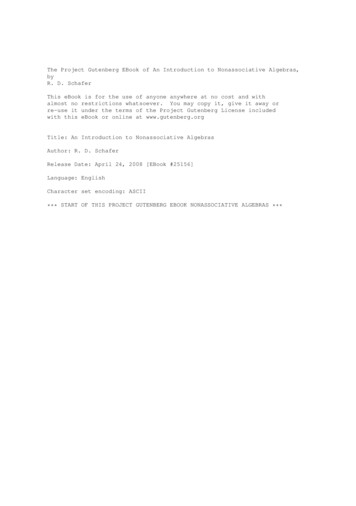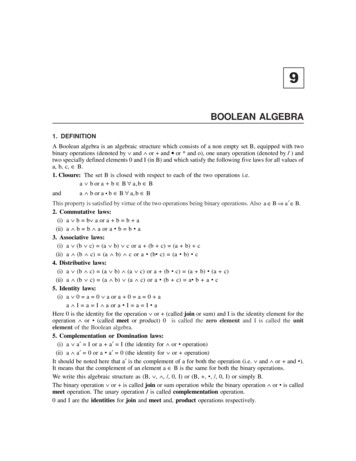
Transcription
Spring Board Algebra 2 Textbook to Curriculum Map Alignment for CC Algebra 2Algebra 2 – UNIT 1Model and Reason with Equations and ExpressionsCritical Area: Students use reasoning to analyze equations/ inequalities and develop strategies for solving them. Through reasoning students develop fluency writing,interpreting, analyzing and translating between various forms of linear equations and inequalities. By exploring a question about the world around them (mathematicalmodeling) and attempting to answer the question students expand the scope of algebraic operations to solve a wide variety of linear and quadratic real world problems.Students explain why the x-coordinates of the points where the graphs y f(x) and y g(x) intersects and explore cases involving polynomial, rational, absolute value,exponential, and logarithmic functions.CLUSTER(m)Createequations thatdescribe numbersor relationships.COMMON CORE STATE STANDARDSAlgebra – Creating EquationsSpring Board MATHA-CED.1. Create equations and inequalitiesin one variable including ones with absolutevalue and use them to solve problems.Include equations arising from linear andquadratic functions, and simple rational andexponential functions. CA 1-1: One Variable Equations1-2: Two-Variable Equations1-3: Absolute ValueEquations and Inequalities24-1: Exponential Equations24-2: Solving Equations byUsing Logarithms24-3: Logarithmic Equations24-4: Exponential andLogarithmic InequalitiesOTHER RESOURCESIllustrative Mathematics Buying a Car: A-CED.1Basketball: A-CED.1 & A-REI.2How Much Folate: A-CED.2Dimes and Quarters: A-CED.2 & A-CED.3Growing Coffee: A-CED.3 Bernado and Sylvia Playa Game: A-CED.3Clea on an Escalator: A-CED.2Equations and Formulas: A-CED.4Mars Task:Optimization Problems: BoomerangsA-CED.2. Create equations in two or morevariables to represent relationships betweenquantities; graph equations on coordinateaxes with labels and scales. A-CED.3. Represent constraints by equationsor inequalities, and by systems of equationsand/or inequalities, and interpret solutions asviable or non-viable options in a modelingcontext.LAUSD Secondary Mathematics2-1: Graphing Two-VariableEquations2-2: Graphing Systems ofInequalities3-1: Solving Systems of TwoEquations in Two Variables3-2: Solving Systems of threeEquations in Three Variables3-3: Matrix Operations3-4: Solving Matrix Equations20 April 2015Page 1
(m)Understandsolving equationsas a process ofreasoning andexplain thereasoning.(m)Solve equationsand inequalities inone variable.(m)Represent andsolve equationsand inequalitiesgraphically.Spring Board Algebra 2 Textbook to Curriculum Map Alignment for CC Algebra 210-1: Parabolas andA-CED.4. Rearrange formulas to highlight a Quadratic Equationsquantity of interest, using the same reasoning 10-2:Writing a Quadraticas in solving equations. Function Given Three Points10-3: Quadratic RegressionRadical Equations: A-REI.2Algebra – Reasoning with Equations andInequalitiesMars Task:A-REI.2. Solve simple rational and radicalBuilding and Solving Equations 225-1: Square Root Functionsequations in one variable, and give examples 25-2: Solving Square RootSolving Linear Equations in Two Variablesshowing how extraneous solutions may arise. EquationsSorting Equations and IdentitiesBuilding and Solving Complex Equations25-3: Cube Root Functions25-4: Solving Cube RootEquations30-1: Solving RationalEquations30-2: Solving RationalInequalitiesA-REI.3.1. Solve one-variable equations andMars Task:inequalities involving absolute value,Representing Inequalities Graphicallygraphing the solutions and interpreting themin context. CAA-REI.11. Explain why the x-coordinates ofthe points where the graphs of the equations y f(x) and y g(x) intersect are the solutionsof the equation f(x) g(x); find the solutionsapproximately, e.g., using technology tograph the functions, make tables of values, orfind successive approximations. Include caseswhere f(x) and/or g(x) are linear, polynomial,rational, absolute value, exponential, andlogarithmic functions. LAUSD Secondary Mathematics13-1: Solving a SystemGraphically13-2: Solving a SystemAlgebraically26-1: Square Root Functionsand Regressions26-2: Square Root andQuadratic Functions26-3: Cube Root and CubicFunctions Illustrative MathematicsGrowth Rate: Given growth charts for the heights of girls andboys, students will use slope to approximate rates of changein the height of boys and girls at different ages. Students willuse these approximations to plot graphs of the rate of changeof height vs. age for boys and girls.Introduction to Polynomials - College Fund: A-REI.1120 April 2015Page 2
Spring Board Algebra 2 Textbook to Curriculum Map Alignment for CC Algebra 2Algebra 2 – UNIT 2Structure in Expressions and Arithmetic with PolynomialsCritical Area: Students connect the polynomial operations with the background knowledge of the algorithms found in multi-digit integer operations. Students realize thatthe operations on rational expressions (the arithmetic of rational expressions) are governed by the same rules as the arithmetic of rational numbers. Students analyze thestructure in expressions and write them in equivalent forms. By modeling students expand the scope of algebraic operations to solve a wide variety of polynomialequations and real world problems. Students identify zeros of polynomials, including complex zeros of quadratic polynomials, and make connections between zeros ofpolynomials and solutions of polynomial equations. The role of factoring, as both an aid to the algebra and to the graphing of polynomials, is explored.CLUSTER(m)Interpret thestructure ofexpressions.(m)Writeexpressions inequivalent formsto solve problems.COMMON CORE STATE STANDARDSAlgebra – Seeing Structure in ExpressionsA-SSE.1. Interpret expressions that represent a quantity interms of its context. a. Interpret parts of an expression, such as terms,factors, and coefficients. b. Interpret complicated expressions by viewing one ormore of their parts as a single entity. For example,interpret P(1 r)n as the product of P and a factor notdepending on P. A-SSE.2. Use the structure of an expression to identifyways to rewrite it.A-SSE.4. Derive the formula for the sum of a finitegeometric series (when the common ratio is not 1), anduse the formula to solve problems. For example, calculatemortgage payments. LAUSD Secondary MathematicsSpring Board MATH7-1: Analyzing a QuadraticFunction7-2: Factoring QuadraticExpressions7-3: Solving QuadraticEquations by Factoring7-4: More Uses for Factors14-1: Polynomials14-2: Some Attributes ofPolynomial Functions14-3: Even and Odd Functions27-1: Formulating andGraphing a Rational Function27-2: Formulating andGraphing More RationalFunctions27-3: Identifying AsymptotesOTHER RESOURCESMathematics Assessment ProjectGenerating Polynomials from PatternsComparing InvestmentsSolving Linear Equations in TwoVariablesInterpreting Algebraic ExpressionsIllustrative Mathematics Animal Populations: A-SSE.1, 2 Sum of Even and Odd: A-SSE.2 Seeing Dots: A-SSE.1, 2Zeroes and factorization of a nonpolynomial function: A-SSE.2Trina's Triangles:A-SSE.4Illuminations: NCTMLight it Up!17-1:Algebraic Methods17-2: The FundamentalTheorem of Algebra19-1: Arithmetic Sequences19-2: Arithmetic Series19-3: Sigma Notation20-1: Geometric Sequences20 April 2015Page 3
Spring Board Algebra 2 Textbook to Curriculum Map Alignment for CC Algebra 220-2: Geometric Series20-3: Convergence of Series(m)Performarithmeticoperations onpolynomials.Algebra – Arithmetic with Polynomials and RationalExpressionsA-APR.1. Understand that polynomials form a systemanalogous to the integers, namely, they are closed underthe operations of addition, subtraction, and multiplication;add, subtract, and multiply polynomials.Understand therelationshipbetween zeros andfactors ofpolynomials.A-APR.2. Know and apply the Remainder Theorem: Fora polynomial p(x) and a number a, the remainder ondivision by x – a is p(a), so p(a) 0 if and only if (x – a)is a factor of p(x).A-APR.3. Identify zeros of polynomials when suitablefactorizations are available, and use the zeros to constructa rough graph of the function defined by the polynomial.Use polynomialidentities to solveproblems.Rewrite rationalexpressions.Illuminations NCTMPolynomial Puzzler Overhead15-1:Adding and SubtractingPolynomials15-2: Multiplying Polynomials15-3: Dividing Polynomials18-1: Graphing PolynomialFunctions18-2: Finding the Roots of aPolynomial Function18-3: Comparing PolynomialFunctionsA-APR.4. Prove polynomial identities and use them todescribe numerical relationships. For example, thepolynomial identity (x2 y2)2 (x2 – y2)2 (2xy)2 can beused to generate Pythagorean triples.33-1: The Pythagorean Identity33-2: Other TrigonometricIdentitiesA-APR.5. Know and apply the Binomial Theorem for theexpansion of (x y)n in powers of x and y for a positiveinteger n, where x and y are any numbers, withcoefficients determined for example by Pascal’sTriangle.( )A-APR.6. Rewrite simple rational expressions in differentforms; write a(x)/b(x) in the form q(x) r(x)/b(x), wherea(x), b(x), q(x), and r(x) are polynomials with the degreeof r(x) less than the degree of b(x), using inspection, longdivision, or, for the more complicated examples, acomputer algebra system.( )A-APR.7. Understand that rational expressions form asystem analogous to the rational numbers, closed under16-1: Introduction to Pascal’sTriangle16-2: Applying the BinomialTheoremLAUSD Secondary Mathematics Zeroes and factorization of a quadraticpolynomial I: A-APR.2Zeroes and factorization of a quadraticpolynomial II: A-APR.215-1:Adding and SubtractingPolynomials15-2: Multiplying Polynomials15-3: Dividing Polynomials29-1: Multiplying and DividingRational Expressions29-2: Adding and SubtractingRational Expressions20 April 2015Page 4
Spring Board Algebra 2 Textbook to Curriculum Map Alignment for CC Algebra 2addition, subtraction, multiplication, and division by a29-3: Finding Horizontal andnonzero rational expression; add, subtract, multiply, andVertical Asymptotesdivide rational expressions.29-4: Graphing RationalFunctionsLAUSD Secondary Mathematics20 April 2015Page 5
Spring Board Algebra 2 Textbook to Curriculum Map Alignment for CC Algebra 2Algebra 2 – UNIT 3FUNCTIONSCritical Area: Instructional time should focus on relating arithmetic of rational expressions to arithmetic of rational numbers. Students identify zeros of polynomials,including complex zeros of quadratic polynomials, and make connections between zeros of polynomials and solutions of polynomial equations. Students will expandunderstandings of functions and graphing to include trigonometric functions. Building on their previous work with functions and on their work with trigonometric ratiosand circles in the Geometry course, students now use the coordinate plane to extend trigonometry to model periodic phenomena. Students synthesize and generalize whatthey have learned about a variety of function families. They extend their work with exponential functions to include solving exponential equations with logarithms. Theyexplore the effects of transformations on graphs of diverse functions, including functions arising in an application, in order to abstract the general principle thattransformations on a graph always have the same effect regardless of the type of the underlying function.CLUSTER(m) Interpreting functionsthat arise in applicationsin terms of the context(m) Analyze FunctionsUsing DifferentRepresentationsLAUSD Secondary MathematicsCOMMON CORE STATE STANDARDSFunctions – Interpreting FunctionsF-IF.4. For a function that models a relationshipbetween two quantities, interpret key features ofgraphs and tables in terms of the quantities, andsketch graphs showing key features given a verbaldescription of the relationship. Key featuresinclude: intercepts; intervals where the function isincreasing, decreasing, positive, or negative;relative maximums and minimums; symmetries;end behavior; and periodicity. F-IF.5 Relate the domain of a function to its graphand, where applicable, to the quantitativerelationship it describes. F-IF.6 Calculate and interpret the average rate ofchange of a function (presented symbolically or asa table) over a specified interval. Estimate the rateof change from a graph. Spring Board MATHOTHER RESOURCESIllustrative MathematicsRunning Time: F-IF.7cGraphs of Power Functions: F-IF.7cExponentials and Logarithms II28-1: Inverse Variation andCombined Variation28-2: Transformations of theParent Rational Function21-1: Exploring ExponentialPatterns21-2: Exponential Functions21-3: Properties of Logarithms21-4: More Properties ofLogarithms22-1: Exponential Data22-2: The Common LogarithmFunction22-3: Properties of Logarithms22-4: More Properties ofLogarithms27-1: Formulating and Graphing aRational Function27-2: Formulating and GraphingMathematics Assessment ProgramInterpreting Functions 1Sorting FunctionsSkeleton TowerBest Buy TicketsMathematics Vision ProjectPolynomial Functions20 April 2015Page 6
Spring Board Algebra 2 Textbook to Curriculum Map Alignment for CC Algebra 2More Rational Functions27-3: Identifying AsymptotesF-IF.7 Graph functions expressed symbolically andshow key features of the graph, by hand in simplecases and using technology for more complicatedcases. b. Graph square root, cube root, andpiecewise-defined functions, including stepfunctions and absolute value functions. c. Graph polynomial functions, identifyingzeros when suitable factorizations areavailable, and showing end behavior. e. Graph exponential and logarithmicfunctions, showing intercepts and endbehavior, and trigonometric functions, showingperiod, midline, and amplitude. (m) Build a function thatmodels a relationshipbetween two quantities(s) Build new functionsLAUSD Secondary Mathematics4-1: Introduction to PiecewiseDefined Functions4-2: Step Functions and AbsoluteValue Functions4-3: Transforming the AbsoluteValue Parent Function34-1: Periodic Functions34-2: The Sine Function34-3: The Cosine Function34-4:The Tangent Function34-5: Translating TrigonometricFunctionsF-IF.8 Write a function defined by an expression indifferent but equivalent forms to reveal and explaindifferent properties of the function.F-IF.9 Compare properties of two functions eachrepresented in a different way (algebraically,graphically, numerically in tables, or by verbaldescriptions).Functions – Building FunctionsF-BF.1 Write a function that describes arelationship between two quantities. b. Combine standard function types usingarithmetic operations. For example, build afunction that models the temperature of a coolingbody by adding a constant function to a decayingexponential, and relate these functions to themodel. 11-1: Translations of Parabolas11-2: Shrinking, Stretching, andReflecting Parabolas11-3: Vertex FormF-BF.3 Identify the effect on the graph of replacing4-1: Introduction to Piecewise-5-1: Operations with Functions5-2: Function Composition5-3: More Function Composition23-1: Logarithms in Other Bases23-2: Properties of Logarithmsand the Change of Base Formula23-3: Graphs of LogarithmicFunctionsInside MathematicsMeasuring Mammals- F-BF.4Illustrative MathematicsExponentials and Logarithms I: F-BF.4Mars Task:Table Tiles20 April 2015Page 7
from existing functions(s) Construct andcompare linear,quadratic, andexponential models andsolve problems(s) Perform arithmeticoperations with complexnumbersLAUSD Secondary MathematicsSpring Board Algebra 2 Textbook to Curriculum Map Alignment for CC Algebra 2Representing Polynomials GraphicallyDefined Functionsf(x) by f(x) k, kf(x), f(kx), and f(x k) for specific4-2: Step Functions and Absolutevalues of k (both positive and negative); find thevalue of k given the graphs. Experiment with cases Value Functions4-3: Transforming the Absoluteand illustrate an explanation of the effects on thegraph using technology. Include recognizing evenValue Parent Functionand odd functions from their graphs and algebraic11-1: Translations of Parabolasexpressions for them.11-2: Shrinking, Stretching, andReflecting ParabolasMathematics Vision Project:Functions and Their Inverses11-3: Vertex FormLogarithmic FunctionsF-BF.4 Find inverse functions.12-1: Key Features of Quadratica. Solve an equation of the form f(x) c for aFunctionssimple function f that has an inverse and write an12-2: More Key Features of3expression for the inverse. For example, f(x) 2xQuadratic Functionsor f(x) (x 1)/(x 1) for x 112-3: Graphing QuadraticFunctions12-4: The Discriminant12-5: Graphing QuadraticInequalities6-1: Finding Inverse Functions6-2: Graphs of Inverse FunctionsFunctions – Linear, Quadratic, and ExponentialIllustrative MathematicsModels21-1: Exploring ExponentialBacteria Populations: F-LE.4F-LE.4 For exponential models, express as aPatternsIlluminations:ctlogarithm the solution to ab d where a, c, and d21-2: Exponential FunctionsLogarithms Demystifiedare numbers and the base b is 2, 10, or e; evaluate 21-3: Properties of Logarithmsthe logarithm using technology. [Logarithms as21-4: More Properties ofMars Tasksolutions for exponentials.]LogarithmsRepresenting Polynomials Graphically4.1 Prove simple laws of logarithms. CA Having Kittens22-1:ExponentialData4.2 Use the definition of logarithms to translateRepresenting Functions of Everyday22-2:TheCommonLogarithmbetween logarithms in any base. CA SituationsFunction22-3: Properties of Logarithms22-4: More Properties ofLogarithmsNumber and Quantity – Complex NumberSystem8-1: The Imaginary Unit, iIllustrative MathematicsComplex number patterns: N-CN.120 April 2015Page 8
Spring Board Algebra 2 Textbook to Curriculum Map Alignment for CC Algebra 2Powers of a complex number: N-CN.28-2: Operations with ComplexN-CN.1.Know there is a complex number i suchCompleting the square: N-CN.7; A-REI.4that i2 1, and every complex number has theNumbers8-3: Factoring with Complexform a bi with a and b real.N-CN.2. Use the relation i2 –1 and theNumberscommutative, associative, and distributiveMars Taskproperties to add, subtract, and multiply complexEvaluating Statements about Radicals(s) Use complex numbersin polynomial identitiesand equations. [Polynomialswith real coefficients.]LAUSD Secondary Mathematicsnumbers.N-CN.7 Solve quadratic equations with realcoefficients that have complex solutions.N-CN.8 ( ) Extend polynomial identities to the2complex numbers. For example, rewrite x 4 as (x 2i)(x – 2i).N-CN.9 ( ) Know the Fundamental Theorem ofAlgebra; show that it is true for quadraticpolynomials.9-1: Completing the Square andTaking Square Roots9-2: The Quadratic Formula9-3: Solutions of QuadraticEquations17-1:Algebraic Methods17-2: The Fundamental Theoremof Algebra20 April 2015Page 9
Spring Board Algebra 2 Textbook to Curriculum Map Alignment for CC Algebra 2Algebra 2 – UNIT 4Geometry and TrigonometryCritical Area: Students use algebraic manipulation, including completing the square, as a tool for geometric understanding to determine if the equation represents a circleor a parabola. They graph shapes and relate the graphs to the behavior of the functions with the transformation on the variable (e.g. the graph of y f (x 2). Studentsexpand on their understanding of the trigonometric functions first developed in Geometry to explore the graphs of trigonometric functions with attention to the connectionbetween the unit circle representation of the trigonometric functions and their properties, use trigonometric functions to model periodic phenomena. Students usePythagorean identity to find the trig function outputs given the angle and understand that interpretation of sine and cosine yield the Pythagorean Identity.CLUSTERTranslatebetween thegeometricdescription andthe equationfor a conicsectionExtend thedomain of thetrigonometricfunctions usingthe unit circleModel periodicphenomenawithtrigonometricfunctionsCOMMON CORE STATE STANDARDSGeometry – Expressing GeometryProperties with EquationsG-GPE.3.1. Given a quadratic equation ofthe form ax2 by2 cx dy e 0, use themethod for completing the square to put theequation into standard form; identifywhether the graph of the equation is a circle,ellipse, parabola, or hyperbola, and graphthe equation. [In Algebra II, this standardaddresses circles and parabolas only.] CAFunctions – Trigonometric FunctionsF-TF.1. Understand radian measure of anangle as the length of the arc on the unitcircle subtended by the angle.F-TF.2. Explain how the unit circle in thecoordinate plane enables the extension oftrigonometric functions to all real numbers,interpreted as radian measures of anglestraversed counterclockwise around the unitcircle.F-TF.2.1. Graph all 6 basic trigonometricfunctions.F-TF.5. Choose trigonometric functions tomodel periodic phenomena with specifiedamplitude, frequency, and midline. LAUSD Secondary MathematicsSpring Board MATH10-1: Parabolas and Quadratic EquationsOTHER RESOURCESIllustrative Mathematics Resources:Explaining the equation for a circle:G-GPE.3Miscellaneous SourcesGravel Roads and Sinusoidal Patterns:Mathematics Vision Project:Circles and other Conics31-1: Radian Measure31-2: Applying Radian Measure32-1: Placing the Unit Circle on theCoordinate Plane32-2: Special Right Triangles and theUnit Circle35-1: Modeling Periodic PhenomenaIllustrative Mathematics ResourcesTrig Functions and the Unit Circle : F-TF.2NCTM IlluminationsGraphs from the Unit Circle: F-TF.1, 2As the Wheel TurnsMathematics Vision ProjectTrigonometric FunctionsModeling with FunctionsIllustrative Mathematics Resources Foxes and Rabbits Intro Foxes and Rabbits 2 Foxes and Rabbits 3: F-TF.520 April 2015Page 10
Prove andapplytrigonometricidentitiesSpring Board Algebra 2 Textbook to Curriculum Map Alignment for CC Algebra 2Dan MeyerScramblerMars Task Representing Trigonometric FunctionsF-TF.8. Prove the Pythagorean identity33-1: The Pythagorean Identitysin2(θ) cos2(θ) 1 and use it to find sin(θ), 33-2: Other Trigonometric Identitiescos(θ), or tan(θ) given sin(θ), cos(θ), ortan(θ) and the quadrant.LAUSD Secondary Mathematics20 April 2015Page 11
Spring Board Algebra 2 Textbook to Curriculum Map Alignment for CC Algebra 2Algebra 2 – UNIT 5Statistics and ProbabilityCritical Area:Students analyze data to make sound statistical decisions based on probability models. By investigating examples of simulations of experiments and observing outcomesof the data, students gain an understanding of what it means for a model to fit a particular data set. Students develop a statistical question in the form of a hypothesis(supposition) about a population parameter, choose a probability model for collecting data relevant to that parameter, collect data, and compare the results seen in the datawith what is expected under the hypothesis. Students build on their understanding of data distributions to help see how the normal distribution uses area to make estimatesof frequencies (which can be expressed as probabilities). In addition, they can learn through examples the empirical rule, that for a normally distributed data set, 68% of thedata lies within one standard deviation of the mean, and that 95% are within two standard deviations of the mean.CLUSTER(s)Summarize,represent, andinterpret data on asingle count ormeasurement data.Understand andevaluate MMON CORE STATE STANDARDSStatistics and Probability – InterpretingCategorical and Quantitative DataS.ID.4. Use the mean and standard deviation ofa data set to fit it to a normal distribution and toestimate population percentages. Recognize thatthere are data sets for which such a procedure isnot appropriate. Use calculators, spreadsheets,and tables to estimate areas under the normalcurveStatistics and Probability – MakingInferences and Justifying ConclusionsS.IC.1. Understand statistics as a process formaking inferences to be made about populationparameters based on a random sample from thatpopulation.S.IC.2. Decide if a specified model is consistentwith results from a given data-generatingprocess, e.g., using simulation. For example, amodel says a spinning coin falls heads up withprobability 0.5. Would a result of 5 tails in arow cause you to question the model?LAUSD Secondary MathematicsSpring Board MATH36-2:Characteristics of theNormal DistributionOTHER RESOURCESIllustrative /standards/hsSAT Score: S.ID.4Do You Fit In This Car?: S.ID.4Should We Send Out a Certificate?: S.ID.4Mars TaskRepresenting Data with Frequency GraphsRepresenting Data with Box PlotsIllustrative /standards/hs36-1: Shapes of Distributions36-2: Characteristics of theNormal Distribution36-3: z-Scores andProbabilities36-4: Modeling with theNormal Distribution38-1: Devising Simulations38-2: Confirming Data withSimulationsSchool Advisory Panel: S-IC.1Musical Preferences: S-IC.1, S-ID.5Mathematics Vision ProjectStatisticsGeorgia StandardsAdvanced Algebra Unit 1: Inferences and Conclusionsfrom Data20 April 2015Page 12
Make inferencesand justifyconclusions fromsample surveysexperiments, andobservationalstudies.Use probability toevaluate outcomesof decisions.Spring Board Algebra 2 Textbook to Curriculum Map Alignment for CC Algebra 2S.IC.3. Recognize the purposes of and37-1: SurveysIllustrative Mathematics:differences among sample surveys, experiments, 37-2: standards/hsand observational studies; explain how37-3: Observational StudiesStrict Parents: S-IC.1, 3randomization relates to each.Musical Preferences: S-IC.1, S-ID.5S.IC.4. Use data from a sample survey to39-1: Introduction to Marginestimate a population mean or proportion;of Errordevelop a margin of error through the use of39-2: Computing Margin ofMars Tasksimulation models for random sampling.ErrorInterpreting Data: Muddying the WatersS.IC.5. Use data from a randomized experiment 40-1: Random ChanceDevising a Measure: Correlationto compare two treatments; use simulations to40-2: Testing Statisticaldecide if differences between parameters areSignificancesignificant.S.IC.6. Evaluate reports based on data.Statistics and Probability – Using Probabilityto Make DecisionsS.MD.6. ( ) Use probabilities to make fairActivity 36- Pg. 573decisions (e.g., drawing by lots, using a randomnumber generator).S.MD.7. ( ) Analyze decisions and strategiesInside Mathematics:using probability concepts (e.g., product testing,Fair Gamesmedical testing, pulling a hockey goalie at theend of a game).LAUSD Secondary Mathematics20 April 2015Page 13
Spring Board Algebra 2 Textbook to Curriculum Map Alignment for CC Algebra 2 LAUSD Secondary Mathematics 20 April 2015 Page 2 A-CED.4. Rearrange formulas to highlight a quantity of interest, using the same reasoning as in solving equations. 10-1: Parabolas and Quadratic Equations 10-2:Writing a Quadratic Function Given Three Points











